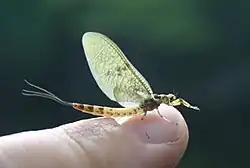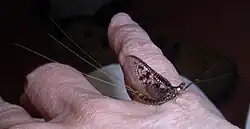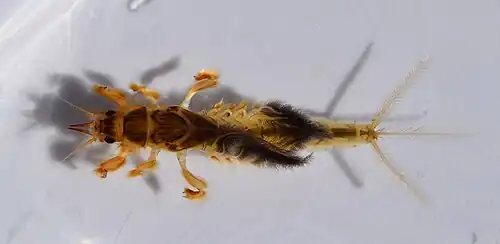Ephemeridae
| Ephemeridae | |
|---|---|

| |
| Ephemera danica | |
| Scientific classification | |
| Kingdom: | Animalia |
| Phylum: | Arthropoda |
| Class: | Insecta |
| Order: | Ephemeroptera |
| Suborder: | Schistonota |
| Superfamily: | Ephemeroidea |
| Family: | Latreille, 1810 |
Ephemeridae[1] is a family of mayflies with about 150 described species found throughout the world except Australia and Oceania.[2]
Description
Ephemerids are generally quite large mayflies (up to 35 mm) with either two or three very long tails. Many species have distinctively patterned wings.[3] They breed in a wide range of waters, usually requiring a layer of silt as the nymphs have strong legs which are adapted for burrowing (the group is sometimes known as burrowing mayflies).

Nymphal Ecology
Ephemerid nymphs are known to possess special adaptations to aid in their burrowing lifestyles. “Fossorial Foretibia” or spur-like projections on their wide legs enhance their burrowing ability. While digging and living in substrate, water can be muddied and oxygen can be difficult to absorb. Ephemerids possess plumose and lanceolate shaped abdominal gills to combat this obstacle. Unlike other Ephemeropteran families, Ephemeridae gills are slightly more dorsal in position, this prevents loose substrate from getting caught while burrowing. The greater surface area of the gill amplifies the insect’s ability to take in oxygen in dirtied water, or while submerged in substrate. These gills can also be moved like fins to create currents to move oxygenated water. Another characteristic ephemerids display are mandibular “tusk” like projections on their head, these tusks help move substrate out of the way while burrowing, with the foretibia acting like shovels and move substrate back. [4][5]

Emphemeridae can be found in lotic and lentic freshwater systems and are generally widespread in the Nearctic. They can be found burrowing in several types of substrate including sand, gravel and silt[6]. Similar to the rest of the order of Ephemeroptera, Empheridae does require higher levels of oxygen and has a low tolerance for pollution. [7][5]
The family is generally regarded as collectors and gatherers. Considering this family occupies “benthic” freshwater zones, the primary food source is decomposing organic matter, and are designated as detritivores. [6]
Genera
The Global Biodiversity Information Facility[2] includes:
- Afromera Demoulin, 1955
- Denina McCafferty, 1987
- Eatonica Navás, 1913
- Eatonigenia Ulmer, 1939
- Ephemera Linnaeus, 1758
- Hexagenia Walsh, 1863
- Litobrancha McCafferty, 1971
- Parabaetis Haupt, 1956
- Pentagenia Walsh, 1863
- Phthartus Handlirsch, 1904
References
- ^ February, v belovLast updated 3; 2014 - 9:39am. "Family Ephemeridae - Common Burrower Mayflies". bugguide.net. Retrieved 2025-08-12.
{{cite web}}: CS1 maint: numeric names: authors list (link) - ^ a b Global Biodiversity Information Facility: Family Ephemeridae (retrieved 7 April 2024)
- ^ Chinery, Michael (1986) Collins Guide to the Insects of Britain and Western Europe (Reprinted 1991)
- ^ Neuswanger, Jason. "Mayfly Species Hexagenia limbata (Hexes)". www.troutnut.com. Retrieved 2025-08-12.
- ^ a b c "Family Ephemeroptera Ephemeridae". www.macroinvertebrates.org. Retrieved 2025-08-12.
- ^ a b Merritt, Richard W., ed. (1979). An introduction to the aquatic insects of North America (3. print ed.). Dubuque, Iowa: Kendall/Hunt. ISBN 978-0-8403-8007-4.
- ^ Hilsenhoff, FTV (August 12, 2025). "Pollution Tolerance Values of Aquatic Macroinvertebrate Families" (PDF). www.thewatershed.org (PDF).
{{cite web}}: Check|archive-url=value (help)CS1 maint: url-status (link)
- McGavin, George C. Insects and Spiders 2004
See also
External links
- Fauna Europaea
- Nomina Insecta Nearctica
 Data related to Ephemeridae at Wikispecies
Data related to Ephemeridae at Wikispecies Media related to Ephemeridae at Wikimedia Commons
Media related to Ephemeridae at Wikimedia Commons